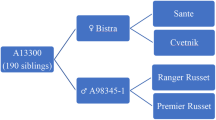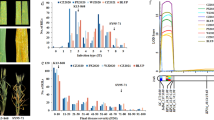Abstract
Three genes, er1, er2 and Er3, conferring resistance to powdery mildew (Erysiphe pisi) in pea have been described so far. Because single gene-controlled resistance tends to be overcome by evolution of pathogen virulence, accumulation of several resistance genes into a single cultivar should enhance the durability of the resistance. Molecular markers linked to genes controlling resistance to E. pisi may facilitate gene pyramiding in pea breeding programs. Molecular markers linked to er1 and er2 are available. In the present study, molecular markers linked to Er3 have been obtained. A segregating F2 population derived from the cross between a breeding line carrying the Er3 gene, and the susceptible cultivar ‘Messire’ was developed and genotyped. Bulk Segregant Analysis (BSA) was used to identify Random Amplified Polymorphic DNA (RAPD) markers linked to Er3. Four RAPD markers linked in coupling phase (OPW04_637, OPC04_640, OPF14_1103, and OPAH06_539) and two in repulsion phase (OPAB01_874 and OPAG05_1240), were identified. Two of these, flanking Er3, were converted to Sequence Characterized Amplified Region (SCAR) markers. The SCAR marker SCW4637 co-segregated with the resistant gene, allowing the detection of all the resistant individuals. The SCAR marker SCAB1874, in repulsion phase with Er3, was located at 2.8 cM from the gene and, in combination with SCW4637, was capable to distinguish homozygous resistant individuals from heterozygous with a high efficiency. In addition, the validation for polymorphism in different genetic backgrounds and advanced breeding material confirmed the utility of both markers in marker-assisted selection.



Similar content being viewed by others
References
Alzate-Marin AL, Nenarim H, Assis De Carvalho G, de Paula Junior TJ, Goncalves de Barros E, Alves Moreira M (1999) Improved selection with newly identified RAPD markers linked to resistance gene to four pathotypes of Colletotrichum lindemuthianum in common bean. Genet Resist 89:281–285
Avila CM, Sillero JC, Rubiales D, Moreno MT, Torres AM (2003) Identification of RAPD markers linked to the Uvf-1 gene conferring hypersensitive resistance against rust (Uromyces viciae-fabae) in Vicia faba L. Theor Appl Genet 107:353–358
Ek M, Eklund M, von Post R, Dayteg C, Henriksson T, Weibull P, Ceptilis A, Issac P, Tuvesson S (2005) Microsatellite markers for powdery mildew resistance in pea (Pisum sativum L.). Hereditas 142:86–91
FAOSTAT data (2005) http://faostat.fao.org/
Fondevilla S, Carver TLW, Moreno MT, Rubiales D (2006) Macroscopic and histological characterisation of genes er1 and er2 for powdery mildew resistance in pea. Eur J Plant Pathol 115:309–321
Fondevilla S, Carver TLW, Moreno MT, Rubiales D (2007a) Identification and characterisation of sources of resistance to Erysiphe pisi Syd. in Pisum spp. Plant Breed 126:113–119
Fondevilla S, Torres AM, Moreno MT, Rubiales D (2007b) Identification of a new gene for resistance to powdery mildew in Pisum fulvum, a wild relative of pea. Breed Sci 57:181–184
Haley SD, Afanador LK, Kelly JD (1994) Selection of monogenic pest resistance traits with coupling- and repulsion-phase RAPDs markers. Crop Sci 34:1061–1066
Heringa RJ, Van Norel A, Tazelaar MF (1969) Resistance to powdery mildew (Erysiphe polygoni D.C.) in peas (Pisum sativum L.). Euphytica 18:163–169
Hu XY, Ohm HW, Dweikat I (1997) Identification of RAPDs markers linked to the gene PM1 for resistance to powdery mildew in wheat. Theor Appl Genet 94:832–840
Janila P, Sharma B (2004) RAPD and SCAR markers for powdery mildew resistance gene er in pea. Plant Breed 123:271–274
Johnson E, Miklas PN, Stavely JR, Martinez-Cruzado JC (1995) RAPDs for markers-assisted selection of PI 181996 rust resistance in common bean. Theor Appl Genet 90:659–664
Kosambi DD (1994) The estimation of map distance from recombination values. Ann Eugen 12:172–175
Lander ES, Green P, Abramson J, Barlow A, Dali MJ, Lincoln DE, Newburg L (1987) MAPMAKER: an interactive computer program for constructing genetic linkage maps of experimental and natural populations. Genomics 1:174–181
Lu YH, Melero-Vara JM, García-Tejada JA, Blanchard P (2000) Development of SCAR markers linked to the gene Or5 conferring resistance to broomrape (Orobanche cumana Wallr.) in sunflower. Theor Appl Genet 100:625–632
Michelmore R, Paran I, Keselli V (1991) Identification of markers linked to disease-resistance genes by bulked segregant analysis: a rapid method to detect markers in specific genomic regions using segregating populations. Proc Natl Acad Sci USA 88:9828–9832
Munjal RL, Chenulu VV, Hora TS (1963) Assessment of losses due to powdery mildew (Erysiphe polygoni) on pea. Indian Phytopathol 19:260–267
Rubiales D, Brown JKM, Martín A (1993) Hordeum chilense resistance to powdery mildew and its potential use in cereal breeding. Euphytica 67:215–220
Tanksley SD, Young ND, Paterson AH, Bonierbale MW (1989) RFLP mapping in plant breeding: new tools for old sciences. Biotechnology 7:257–264
Timmerman-Vaughan GM, Frew TJ, Weeden NF (1994) Linkage analysis of er1, a recessive Pisum sativum gene for resistance to powdery mildew fungus (Erysiphe pisi D.C). Theor Appl Genet 88:1050–1055
Tiwari KR, Penner GA, Warkentin TD, Rashid KY (1997a) Pathogenic variation in Erysiphe pisi, the causal organism of powdery mildew of pea. Can J Plant Pathol 19:267–271
Tiwari KR, Penner GA, Warkentin TD (1997b) Inheritance of powdery mildew resistance in pea. Can J Plant Sci 77:307–310
Tiwari KR, Penner GA, Warkentin TD (1998) Identification of coupling and repulsion phase RAPD markers for powdery mildew resistance gene er1 in pea. Genome 41:440–444
Tiwari KR, Penner GA, Warkentin TD (1999) Identification of AFLP markers for powdery mildew resistance gene er2 in pea. Pisum Genet 31:27–29
Torres AM, Weeden NF, Martín A (1993) Linkage among isozyme, RFLP and RAPD markers in Vicia faba. Theor Appl Genet 85:937–945
Warkentin TD, Rashid KY, Xue AG (1996) Fungicidal control of powdery mildew in field pea. Can J Plant Sci 76:933–935
Williams JGK, Kubelic AR, Livak KJ, Raflaski JA, Tingey SV (1990) DNA polymorphism amplified by arbitrary primers are useful as genetics markers. Nucleic Acids Res 18:6531–6535
Young R, Kelly JD (1997) RAPD markers linked to three major anthracnose resistance genes in common bean. Crop Sci 37:940–946
Acknowledgments
We thank INIA for providing a grant to the senior author and projects FP6-FOOD-CT-2004-506223 and AGL2005-10181 for financial support.
Author information
Authors and Affiliations
Corresponding author
Rights and permissions
About this article
Cite this article
Fondevilla, S., Rubiales, D., Moreno, M.T. et al. Identification and validation of RAPD and SCAR markers linked to the gene Er3 conferring resistance to Erysiphe pisi DC in pea. Mol Breeding 22, 193–200 (2008). https://doi.org/10.1007/s11032-008-9166-6
Received:
Accepted:
Published:
Issue Date:
DOI: https://doi.org/10.1007/s11032-008-9166-6




